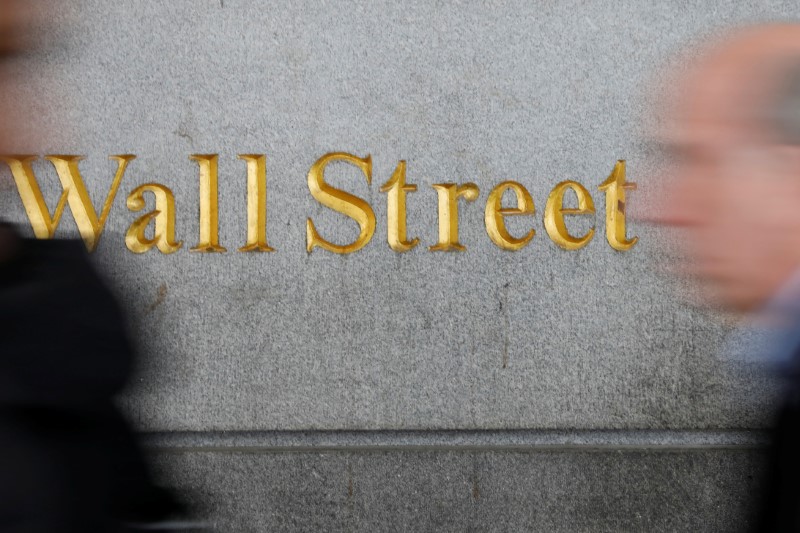 © Reuters. People walk by a Wall Street sign close to the NYSE in New York
© Reuters. People walk by a Wall Street sign close to the NYSE in New YorkBy Shrutee Sarkar
BENGALURU (Reuters) – There is nearly a one-in-three chance of a U.S. recession in the next two years, according to a Reuters poll of economists who cited concerns about an already-old business cycle, as well as rising interest rates and barriers to trade.
The latest poll of over 100 economists taken May 16-24 showed U.S. economic growth was forecast to average 2.8 percent in 2018, its fastest pace in three years, fueled by the biggest tax overhaul since the 1980s.
But as has been in the case in a series of monthly polls, the expected boost was predicted to be short-lived. The economy is forecast to lose some momentum next year, averaging 2.5 percent, slowing further to 1.8 percent in 2020.
When asked on the likelihood of a U.S. recession in the next 12 months, the median of over 70 economists who answered an additional question was 15 percent, around where it has been over the last few years.
But that probability doubled to 31 percent over the next two years, with the most pessimistic call at 70 percent.
“The risk of a recession really picks up after a year, or sometime in 2020 because that is when you start to see the fiscal stimulus start to fade,” said Joseph Song, senior U.S. economist at BofAML.
“That is when you return to trend or potential growth, which is below 2 percent, and if you get some sort of a negative shock – whether it is a normal oil shock, or a dollar shock – then you start to see growth get hurt and potentially turn negative”.
While predicting turning points in economic cycles is no easy task, the recovery from the devastating 2007-2009 financial crisis has been unusually lengthy, and the latest poll showed some signs the current economic expansion will end soon.
An increasing number of economists expect the Federal Reserve to start cutting interest rates sometime in 2020 compared with previous polls.
For now though, continued strength in the economy has pushed most policymakers in favor of another interest rate hike “soon”, according to minutes of the Fed’s last policy meeting released on Wednesday.
The central bank will raise rates in June, according to all but one of 110 economists polled. Two more hikes will follow this year, taking the fed funds rate to 2.25-2.50 percent, according to the median and a majority of respondents.
If those predictions come true, it will make four rate hikes this year, compared to three projected by the Fed’s own dot plots.
While inflation expectations were unchanged compared with the previous poll, it was forecast to reach the Fed’s target of 2 percent next quarter.
The core PCE price index, the Fed’s preferred inflation measure, was expected to reach 2.1 percent in the third quarter and level out to average slightly above that at 2.2 percent next year. It was last reported at 1.9 percent.
An already-mature U.S. expansion may soon appear even more pronounced compared to the global economy, which is also showing signs of aging. And the threat of trade protectionism escalates is very real.
President Donald Trump, who launched a new investigation into automobile imports that could lead to new U.S. tariffs similar to those imposed on imported steel and aluminum, said he will propose new tax cuts sometime before November.
But as they overwhelmingly did when surveyed before the tax cuts passed by Congress late last year, many economists again warned tax cuts were not warranted at this stage of the business cycle, given the economy is close to full employment.
“Fiscal stimulus is a terrible idea. There is a real argument for changing the tax code to try to simplify it and bring down marginal rates but ideally that should have been done in a deficit-neutral way, similar to the 1986 reform package,” said Jim O’Sullivan, chief economist at High Frequency Economics.
“But clearly, it is adding stimulus at a point of the cycle when fiscal stimulus is not needed. There should be the goal of boosting the supply-side of the economy, absolutely. But the economy right now does not need demand-side stimulus.”
(For other stories from the Reuters global long-term economic outlook polls package see)
Source: Investing.com




























